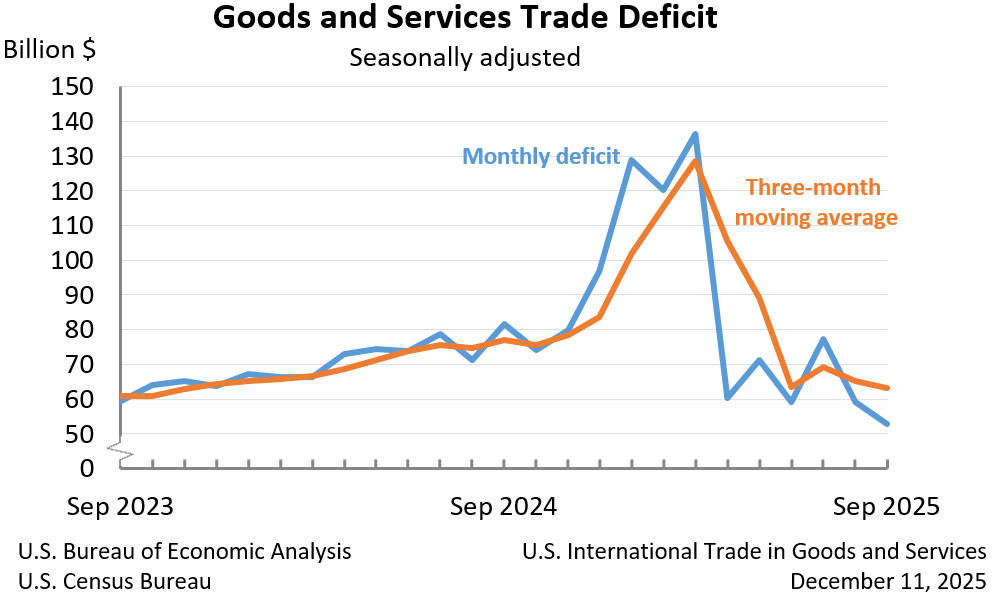Bureau of Economic Analysis
U.S. International Trade in Goods and Services, September 2025
The U.S. goods and services trade deficit decreased in September 2025 according to the U.S. Bureau of Economic Analysis and the U.S. Census Bureau. The deficit decreased from $59.3 billion in August (revised) to $52.8 billion in September, as exports increased more than imports. The goods deficit decreased $7.1 billion in September to $79.0 billion. The services surplus decreased $0.6 billion in September to $26.2 billion.
Principal Federal Economic Indicators
Noteworthy
The Latest
U.S. International Trade in Goods and Services, January 2015
U.S. Census Bureau U.S. Bureau of Economic Analysis NEWS U.S. Department of Commerce * Washington, DC 20230 U.S. INTERNATIONAL TRADE IN GOODS AND SERVICES January 2015 The U.S. Census Bureau and the U.S.
Real Disposable Income Rises In January
Personal income rose 0.3 percent in January, the same increase as in December. Wages and salaries, the largest component of personal income, rose 0.6 percent in January after rising 0.1 percent in December.
Current-dollar disposable personal income (DPI), after-tax income, rose 0.4 percent in January after rising 0.3 percent in December.
Real DPI, income adjusted for taxes and inflation, increased 0.9 percent in…
Personal Income and Outlays, January 2015
Personal income increased $50.8 billion, or 0.3 percent, and disposable personal income (DPI) increased $52.6 billion, or 0.4 percent, in January, according to the Bureau of Economic Analysis. Personal consumption expenditures (PCE) decreased $18.9 billion, or 0.2 percent.
GDP Increases in Fourth Quarter
Real gross domestic product (GDP) increased 2.2 percent in the fourth quarter of 2014, according to the “second” estimate released by the Bureau of Economic Analysis. The growth rate was 0.4 percentage point less than the “advance” estimate released in January. In the third quarter, real GDP increased 5.0 percent.
Gross Domestic Product, 4th quarter and annual 2014 (second estimate)
Real gross domestic product -- the value of the production of goods and services in the United States, adjusted for price changes -- increased at an annual rate of 2.2 percent in the fourth quarter of 2014, according to the "second" estimate released by the Bureau of Economic Analysis. In the third quarter, real GDP increased 5.0 percent. The GDP estimate released today is based on more complete source data than were available for…
How Do Corporate Inversions Affect the International and National Economic Accounts?
Recently, a growing number of articles in the media have noted U.S. corporations announcing that they intend to move their headquarters overseas. This practice is known as a corporate inversion, which occurs when a U.S. corporation that is currently the ultimate owner of its worldwide operations takes steps to become a wholly owned subsidiary of a foreign corporation.
BEA Constantly Innovates to Produce New Statistics Measuring the U.S. Economy
The Bureau of Economic Analysis is producing new economic statistics over the course of this year that offer businesses and households additional tools to make informed decisions and illustrate BEA’s innovative approach to better measure the dynamic U.S. economy.
December 2014 Trade Gap is $46.6 Billion
The U.S. monthly international trade deficit increased in December 2014 according to the U.S. Bureau of Economic Analysis and the U.S. Census Bureau. The deficit increased from $39.8 billion in November (revised) to $46.6 billion in December, as exports decreased and imports increased. The previously published November deficit was $39.0 billion. The goods deficit increased $6.9 billion from November to $66.0 billion in December. The…
2014 Trade Gap is $505.0 Billion
The U.S. international trade deficit increased in 2014, according to the U.S. Bureau of Economic Analysis and the U.S. Census Bureau. The deficit increased from $476.4 billion in 2013 to $505.0 billion in 2014, as imports increased more than exports. As a percentage of U.S. gross domestic product, the goods and services deficit was 2.9 percent in 2014, up from 2.8 percent in 2013. The goods deficit increased from $701.7 billion in 2013 to $…
U.S. International Trade in Goods and Services, December 2014
U.S. Census Bureau U.S. Bureau of Economic Analysis NEWS U.S. Department of Commerce * Washington, DC 20230 U.S. INTERNATIONAL TRADE IN GOODS AND SERVICES December 2014 The U.S. Census Bureau and the U.S.




